Multi-Mode Interferometry: Application to TiO2–SiO2 Sol-Gel Waveguide-Based Sensing in the Aerospace Domain
Abstract
:1. Introduction
2. Materials and Methods
2.1. Sol-Gel Elaboration
2.2. Creation of TiO2–SiO2 Photonic Devices
2.3. Characterization of TiO2–SiO2 Devices
2.4. Simulation Tools: Waveguides and MMI Couplers
3. Results and Discussion
3.1. Creation of TiO2–SiO2 Waveguides by Direct Laser Writing Technique
3.2. Optical Fiber and Sol-Gel Waveguide Coupling: Simulation of Connection Losses
3.3. 1 × 3 MMI Coupler Simulation
3.4. TiO2–SiO2 MMI Couplers Manufacturing
3.5. Creation of 1 × 3 and 1 × 9 MMI Couplers
3.6. Toward the Development of More Compact Architectures (1 × 45)
3.7. Behavior of TiO2–SiO2 Waveguides with Respect to Several Thermal Cycles
4. Conclusions
Author Contributions
Funding
Institutional Review Board Statement
Informed Consent Statement
Data Availability Statement
Acknowledgments
Conflicts of Interest
References
- Güemes, A.; Fernandez-Lopez, A.; Pozo, A.R.; Sierra-Pérez, J. Structural Health Monitoring for Advanced Composite Struc-tures: A Review. J. Compos. Sci. 2020, 4, 13–27. [Google Scholar] [CrossRef] [Green Version]
- Bezas, K.; Komianos, V.; Koufoudakis, G.; Tsoumanis, G.; Kabassi, K.; Oikonomou, K. Structural Health Monitoring in His-torical Buildings: A Network Approach. Heritage 2020, 3, 796–818. [Google Scholar] [CrossRef]
- Kumberg, T.; Schneid, S.; Reindl, L. A Wireless Sensor Network Using GNSS Receivers for a Short-Term Assessment of the Modal Properties of the Neckartal Bridge. Appl. Sci. 2017, 7, 626. [Google Scholar] [CrossRef] [Green Version]
- Dong, T.; Kim, N.H. Cost-Effectiveness of Structural Health Monitoring in Fuselage Maintenance of the Civil Aviation Industry. Aerospace 2018, 5, 87. [Google Scholar] [CrossRef] [Green Version]
- Bhuiyan, M.Y.; Giurgiutiu, V. Multiphysics Simulation of Low-Amplitude Acoustic Wave Detection by Piezoelectric Wafer Active Sensors Validated by In-Situ AE-Fatigue Experiment. Materials 2017, 10, 962–979. [Google Scholar] [CrossRef] [PubMed] [Green Version]
- Smithard, J.; Rajic, N.; Van Der Velden, S.; Norman, P.; Rosalie, C.; Galea, S.; Mei, H.; Lin, B.; Giurgiutiu, V. An Advanced Multi-Sensor Acousto-Ultrasonic Structural Health Monitoring System: Development and Aerospace Demonstration. Mater. 2017, 10, 832. [Google Scholar] [CrossRef] [Green Version]
- Di Sante, R. Fibre Optic Sensors for Structural Health Monitoring of Aircraft Composite Structures: Recent Advances and Applications. Sensors 2015, 15, 18666–18713. [Google Scholar] [CrossRef]
- Lee, B.H.; Kim, Y.H.; Park, K.S.; Eom, J.B.; Kim, M.J.; Rho, B.S.; Choi, H.Y. Interferometric Fiber Optic Sensors. Sensors 2012, 12, 2467–2486. [Google Scholar] [CrossRef] [PubMed] [Green Version]
- Takeda, N.; Okabe, Y.; Mizutani, T. Damage detection in composites using optical fibre sensors. Proc. Inst. Mech. Eng. Part G J. Aerosp. Eng. 2007, 221, 497–508. [Google Scholar] [CrossRef]
- Royon, M.; Jamon, D.; Blanchet, T.; Royer, F.; Vocanson, F.; Marin, E.; Morana, A.; Boukenter, A.; Ouerdane, Y.; Jourlin, Y.; et al. Sol–Gel Waveguide-Based Sensor for Structural Health Monitoring on Large Surfaces in Aerospace Domain. Aerosp. 2021, 8, 109. [Google Scholar] [CrossRef]
- Hench, L.L.; West, J.K. The Sol-Gel Process. Chem. Rev. 1990, 90, 33–72. [Google Scholar] [CrossRef]
- Jerónimo, P.C.; Araújo, A.N.; Montenegro, M. Optical sensors and biosensors based on sol–gel films. Talanta 2007, 72, 13–27. [Google Scholar] [CrossRef] [PubMed]
- Gelover, S.; Mondragón, P.; Jiménez, A. Titanium Dioxide Sol-Gel Deposited Over Glass and Its Application as a Photocatalyst for Water Decontamination. J. Photochem. Photobiol. A 2003, 165, 241–246. [Google Scholar] [CrossRef]
- Oubaha, M.; Kribich, R.K.; Copperwhite, R.; Etienne, P.; O’Dwyer, K.; MacCraith, B.D.; Moreau, Y. New Inorganic Sol-Gel Material with High Transparency at 1.55 µm. Opt. Commun. 2005, 253, 346–351. [Google Scholar] [CrossRef]
- Coudray, P.; Etienne, P.; Moreau, Y. Integrated optics based on organo-mineral materials. Mater. Sci. Semicond. Process. 2000, 3, 331–337. [Google Scholar] [CrossRef]
- Fardad, M.; Mishechkin, O.; Fallahi, M. Hybrid sol-gel materials for integration of optoelectronic components. J. Light. Technol. 2001, 19, 84–91. [Google Scholar] [CrossRef]
- Royon, M.; Vocanson, F.; Jamon, D.; Marin, E.; Morana, A.; Boukenter, A.; Girard, S.; Ouerdane, Y.; Royer, F.; Jourlin, Y. Comparison between the UV and X-ray Photosensitivities of Hybrid TiO2-SiO2 Thin Layers. Materials 2020, 13, 3730–3739. [Google Scholar] [CrossRef]
- Soldano, L.B.; Pennings, E.C.M. Optical multi-mode interference devices based on self-imaging: Principles and applications. J. Light. Technol. 1995, 13, 615–627. [Google Scholar] [CrossRef] [Green Version]
- Bachmann, M.; Besse, P.A.; Melchior, H. General Self-Imaging Properties in N x N Multimode Interference Couplers Including Phase Relations. Appl. Opt. 1994, 33, 3905–3911. [Google Scholar] [CrossRef]
- Hill, M.M.; Leijtens, X.; Khoe, G.G.-D.; Smit, M.M. Optimizing imbalance and loss in 2 x 2 3-db multimode interference couplers via access waveguide width. J. Light. Technol. 2003, 21, 2305–2313. [Google Scholar] [CrossRef]
- Franc, J.; Blanc, D.; Zerroukhi, A.; Chalamet, Y.; Last, A.; Destouches, N. Organo-silica–titania nanocomposite elaborated by sol–gel processing with tunable optical properties. Mater. Sci. Eng. B 2006, 129, 180–185. [Google Scholar] [CrossRef]
- Royon, M.; Vocanson, F.; Jamon, D.; Royer, F.; Marin, E.; Morana, A.; Campanella, C.; Boukenter, A.; Ouerdane, Y.; Jourlin, Y.; et al. Impact of γ-rays Irradiation on Hybrid TiO2-SiO2 Sol-Gel Films Doped with RHODAMINE 6G. Materials 2021, 14, 5754–5765. [Google Scholar] [CrossRef] [PubMed]
- Ștefan, S.; Antonescu, B.; Urlea, A.; Buzdugan, L.; Andrei, M.; Necula, C.; Voinea, S. Study of Clear Air Turbulence Related to Tropopause Folding over the Romanian Airspace. Atmosphere 2020, 11, 1099. [Google Scholar] [CrossRef]


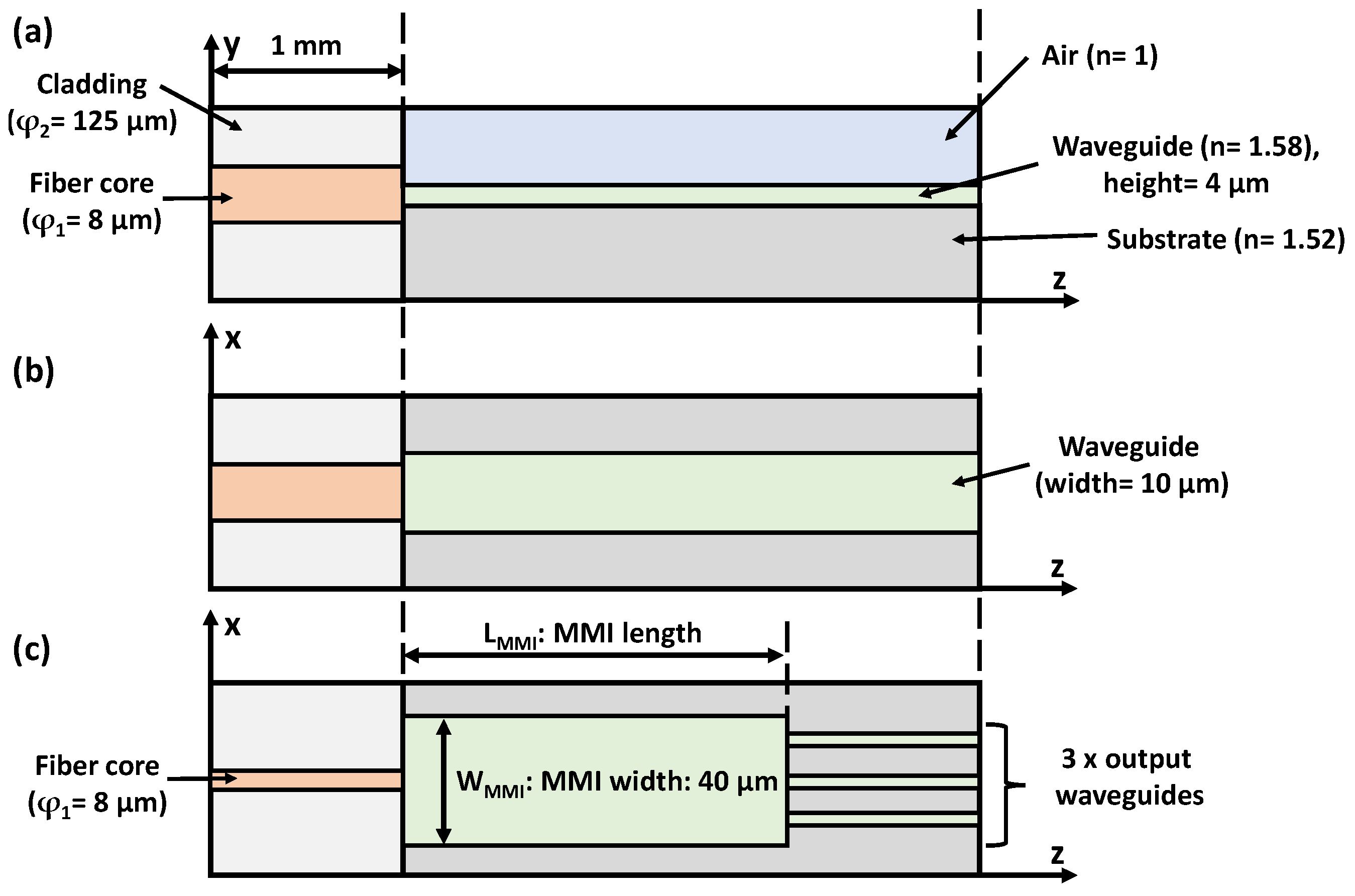

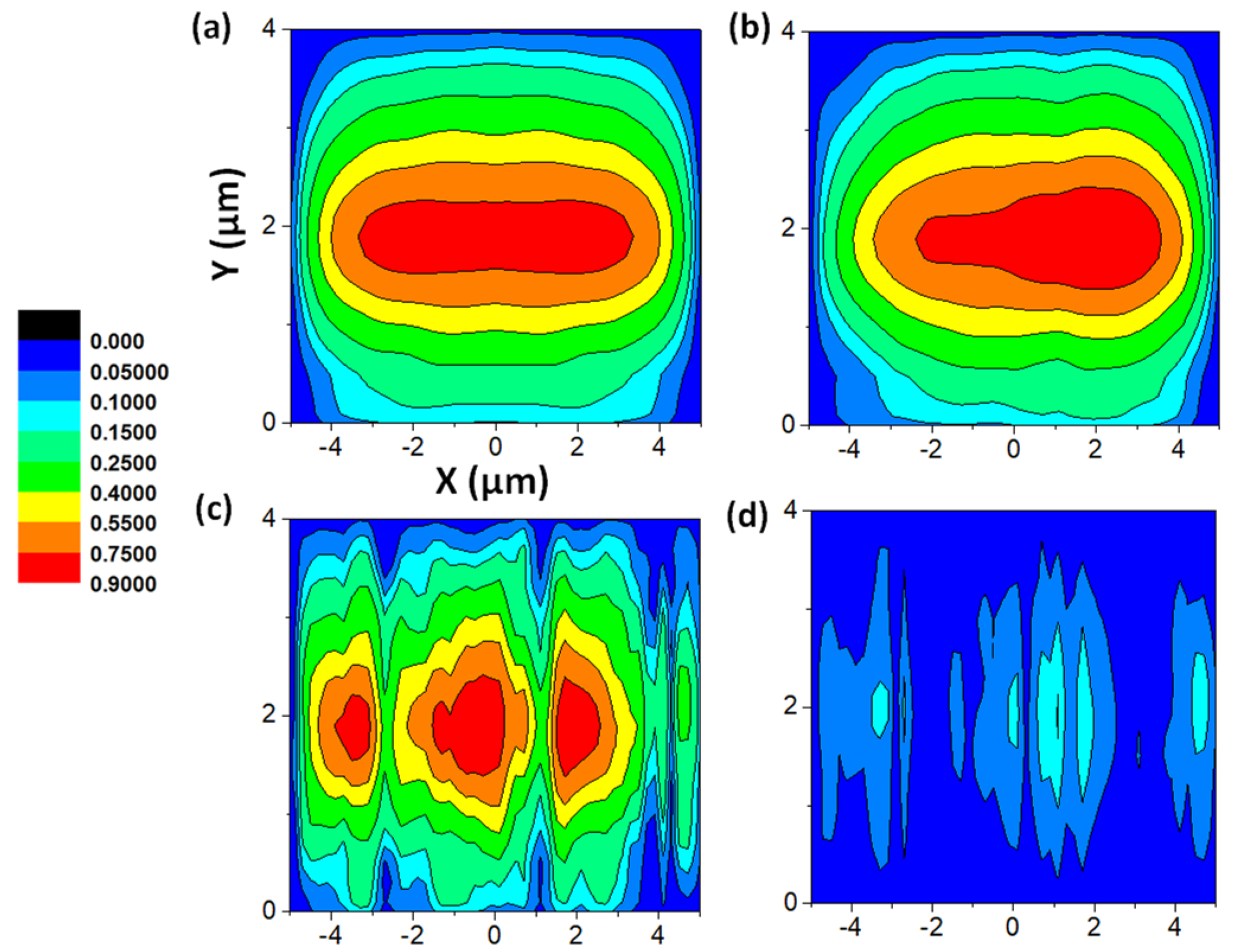

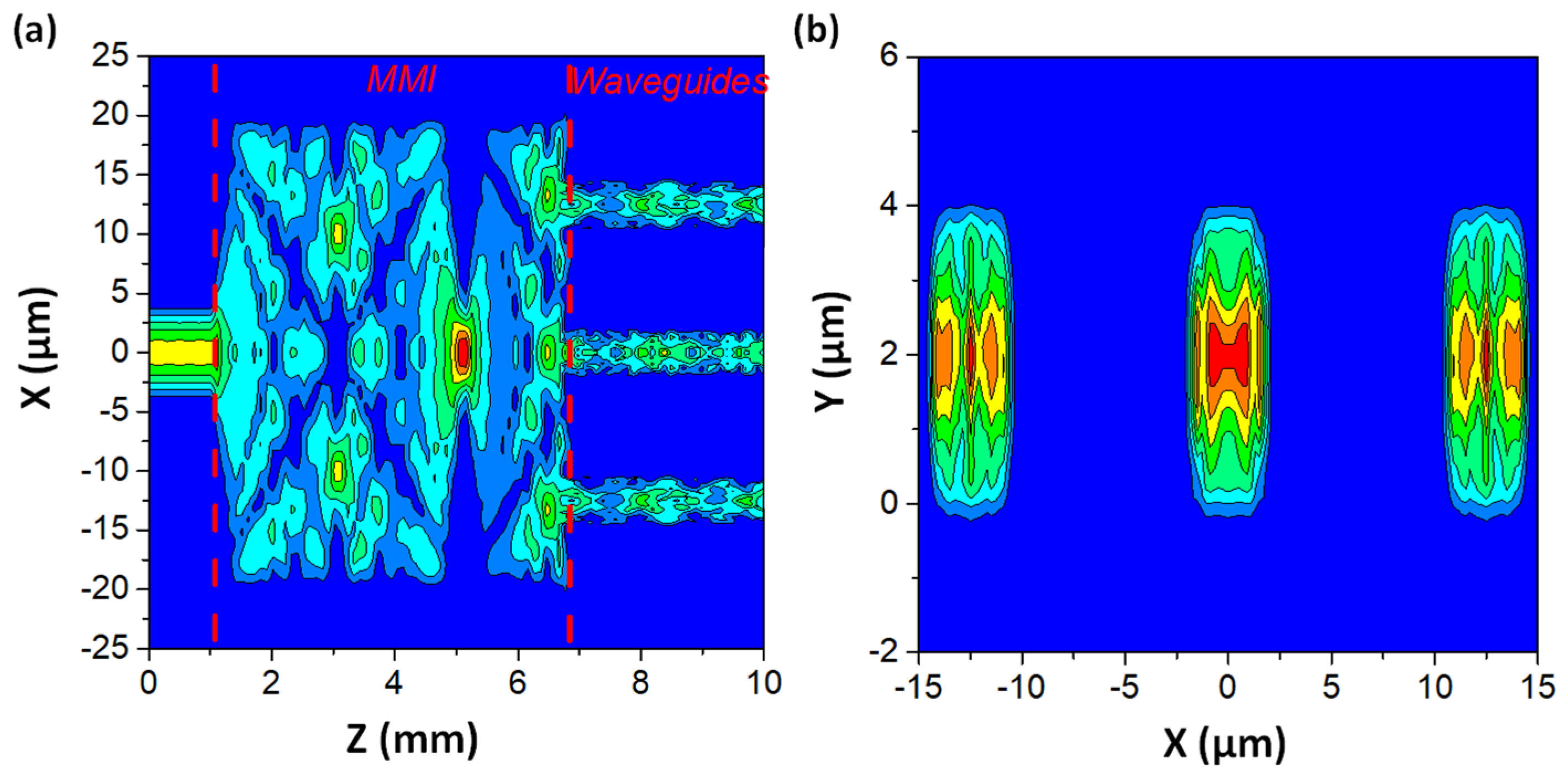
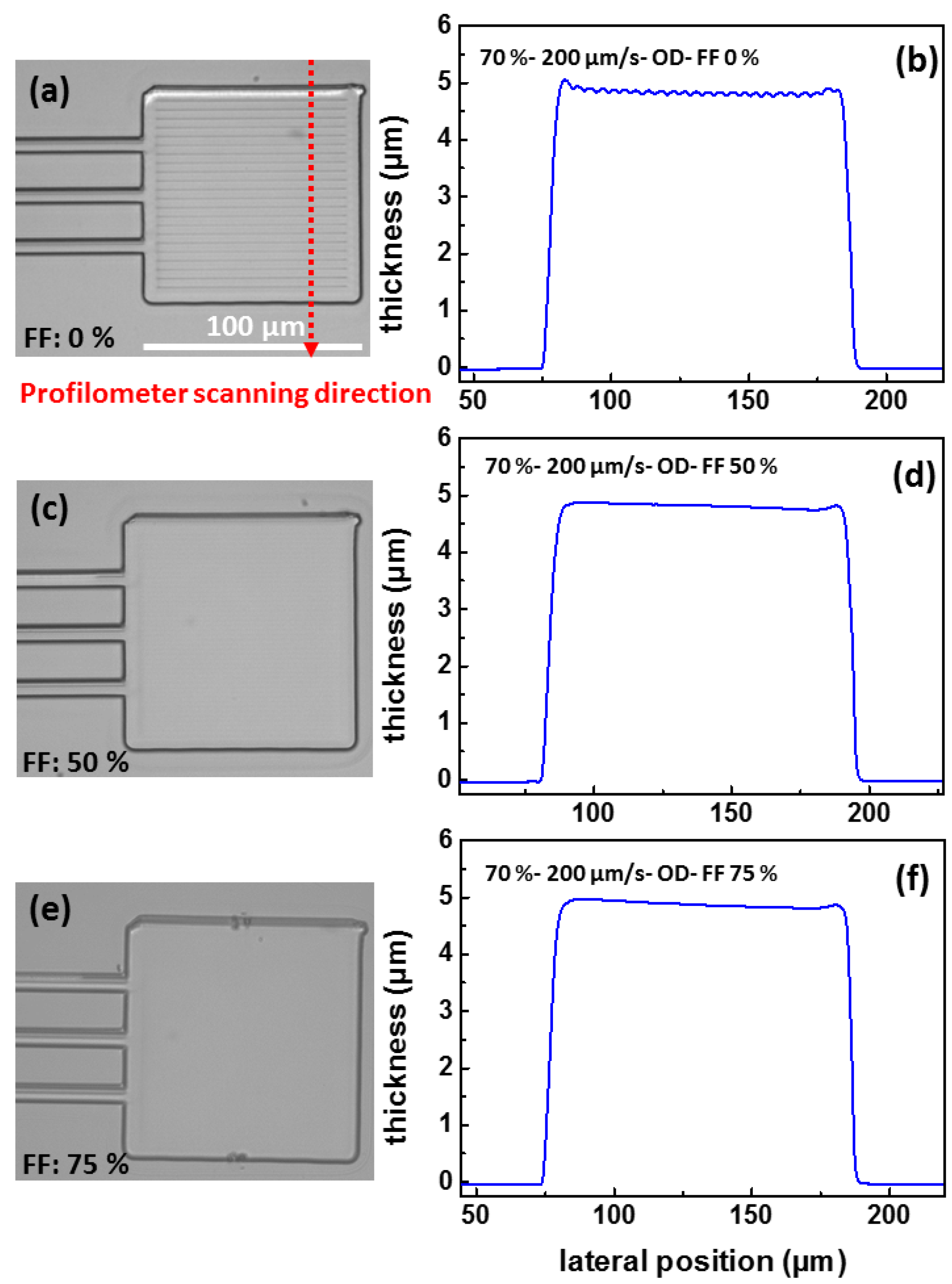



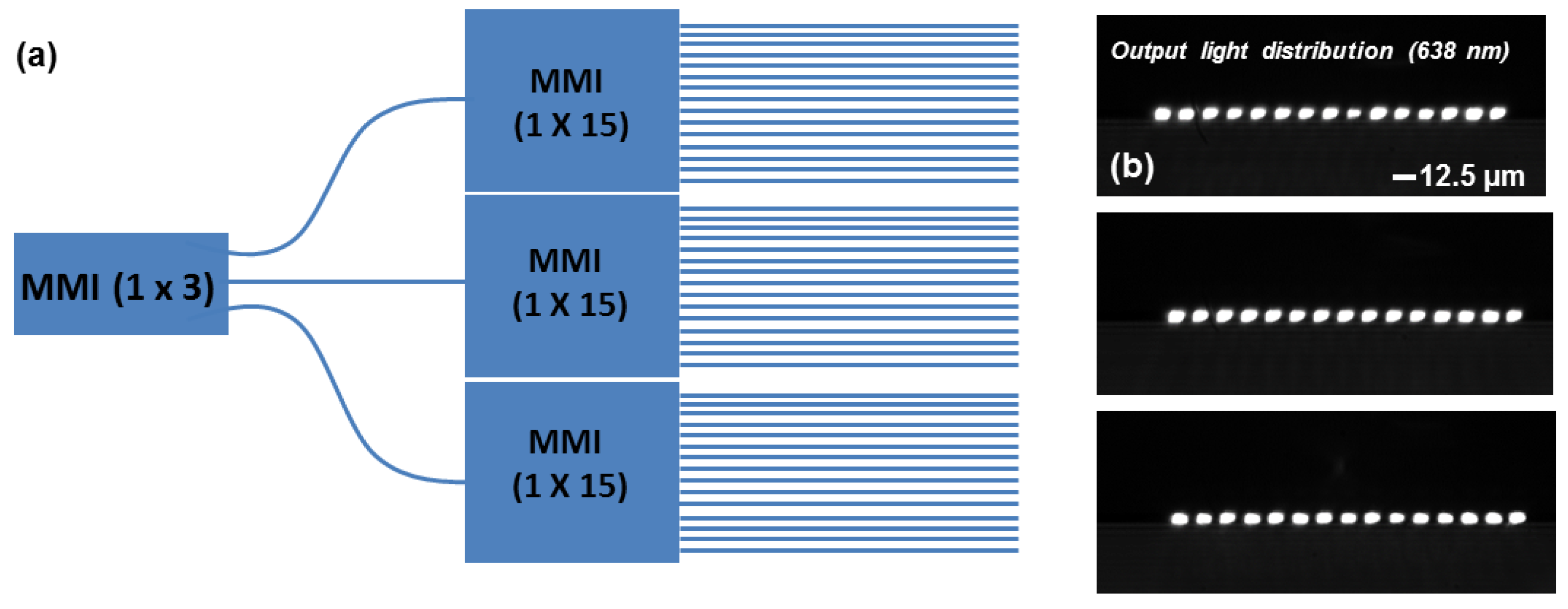
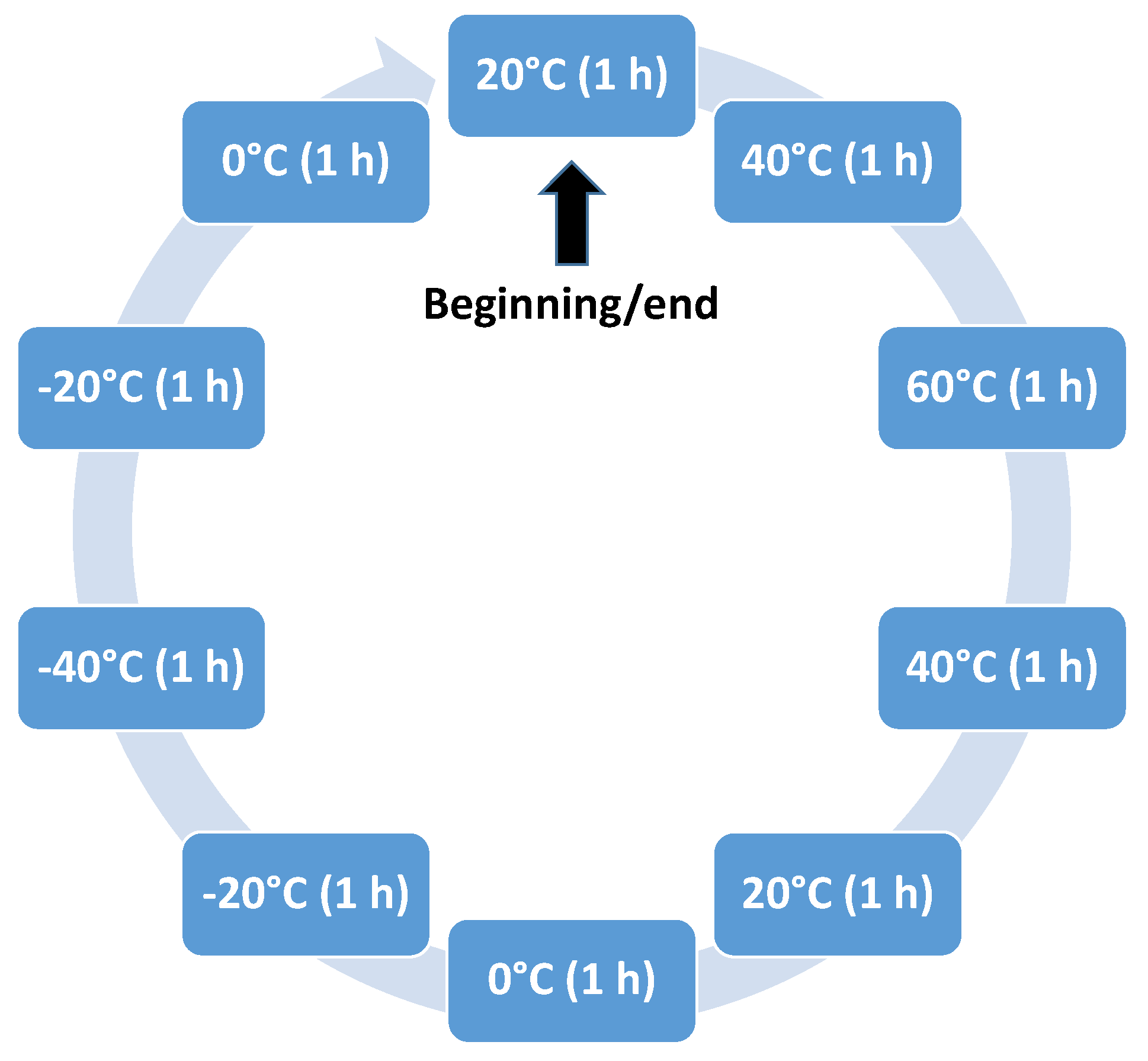

| Waveguide Width (µm) | X-Axis Misalignment (µm) | Connection Losses (%) |
|---|---|---|
| 10 | 0 | 15 |
| 10 | 1 | 15 |
| 10 | 4 | 35 |
| 10 | 8 | 95 |
| 30 | 0 | 15 |
Publisher’s Note: MDPI stays neutral with regard to jurisdictional claims in published maps and institutional affiliations. |
© 2021 by the authors. Licensee MDPI, Basel, Switzerland. This article is an open access article distributed under the terms and conditions of the Creative Commons Attribution (CC BY) license (https://creativecommons.org/licenses/by/4.0/).
Share and Cite
Royon, M.; Blanchet, T.; Adnan, M.; Jamon, D.; Royer, F.; Vocanson, F.; Marin, E.; Morana, A.; Boukenter, A.; Ouerdane, Y.; et al. Multi-Mode Interferometry: Application to TiO2–SiO2 Sol-Gel Waveguide-Based Sensing in the Aerospace Domain. Aerospace 2021, 8, 401. https://doi.org/10.3390/aerospace8120401
Royon M, Blanchet T, Adnan M, Jamon D, Royer F, Vocanson F, Marin E, Morana A, Boukenter A, Ouerdane Y, et al. Multi-Mode Interferometry: Application to TiO2–SiO2 Sol-Gel Waveguide-Based Sensing in the Aerospace Domain. Aerospace. 2021; 8(12):401. https://doi.org/10.3390/aerospace8120401
Chicago/Turabian StyleRoyon, Maxime, Thomas Blanchet, Muhammad Adnan, Damien Jamon, François Royer, Francis Vocanson, Emmanuel Marin, Adriana Morana, Aziz Boukenter, Youcef Ouerdane, and et al. 2021. "Multi-Mode Interferometry: Application to TiO2–SiO2 Sol-Gel Waveguide-Based Sensing in the Aerospace Domain" Aerospace 8, no. 12: 401. https://doi.org/10.3390/aerospace8120401







